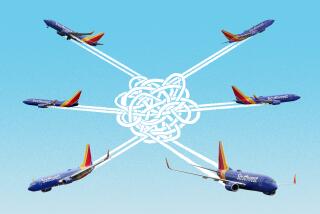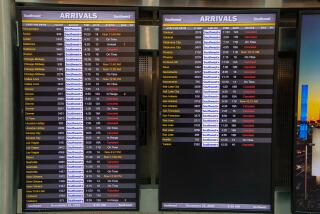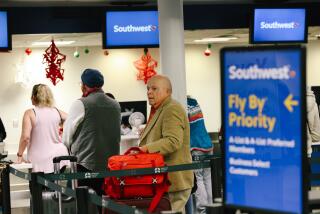Big Plans Bring Bigger Headaches to USAir : Airlines: The firm was still handling problems from purchases of Piedmont and PSA when the industry went into a slump. Then Mother Nature struck.
- Share via
ARLINGTON, Va. — These are not good times for USAir Group, parent of USAir.
Its merger with Piedmont Airlines, the largest in airline history, was planned with patience and precision. But it did not come off as smoothly as had been hoped.
Arlington-based USAir has also been buffeted by natural disasters--Hurricane Hugo and the San Francisco Bay Area earthquake--and by troubles being suffered generally throughout the industry.
But the big problems grew out of the merger. USAir management had paid close attention to the mergers of other airlines, hoping to learn from their mistakes.
That is the way that USAir conducts all of its business, many industry observers say. “Neither flamboyant nor overly aggressive,” is the way Louis Marckesano, airline analyst with the Philadelphia-based brokerage of Janney Montgomery Scott, describes USAir.
“Management has concentrated on developing and on dominating its historical markets in a methodical, low-risk fashion (and) exhibited the same cautious, go-slow approach” in its mergers with both Piedmont and Pacific Southwest Airlines, Marckesano added.
The $1.6-billion purchase of Piedmont took place in April, 1987, but the two airlines’ operations were not fully integrated for 16 months. In 1986, USAir had swallowed up PSA for $313 million.
Despite all USAir’s efforts, there still were significant merger-related expenses and problems, not just with the Piedmont takeover but also with the PSA marriage, which made USAir the airline industry’s largest West Coast operator.
Integrating the operations of the merged airlines cost much more than had been estimated. Everything from computers to pilot training and maintenance procedures needed to be meshed. It cost $30 million just to install first-class service in the planes of the joined airlines. Piedmont was just developing first-class service at the time of the merger and neither USAir nor PSA offered it.
Also, work forces had to be put together, and that job was complicated when some employees refused transfers--taking early retirement or quitting--which resulted in understaffing at some locations. As a result, workers in the field had to take heat from irate customers.
Though new people were hired and trained, morale and performance slipped for a time. Flights were delayed or scratched. Baggage was lost. Spare parts for airliners ended up in the wrong cities. Veteran employees feared that their jobs were in jeopardy.
Costs soared. Edwin I. Colodny, USAir Group’s chairman, said in a recent interview that it is costing USAir $58 million a year to raise the wages of former PSA and Piedmont employees to USAir’s pay scales. And merger-related pilot training and conversion of computer systems will cost the company $40 million this year, about the same as the $37 million it cost last year.
In the third quarter of this fiscal year, USAir suffered its first loss in seven quarters and its first loss in a third quarter in more than 15 years. The carrier reported an operating loss of $71.9 million in the quarter, contrasted with an operating income of $136.7 million in the same period of 1988.
Colodny is candid about the troubles the airline experienced after the final integration with Piedmont on Aug. 5.
“It didn’t run smoothly for a while,” he said in the interview, “despite all the planning. . . . We had a very rough period for about 2 1/2 weeks . . . particularly on the former Piedmont system. On-time performance was very poor. We had cancellations. We knew we were going to take a hit on the merger.”
But the kinks were slowly worked out, and things began to improve. The new USAir was getting its act together.
But then, on Sept. 22, came Hugo.
“We were doing quite well until the hurricane,” Colodny recalled. “That hurricane busted us up pretty badly. . . . Charlotte, N.C., (where USAir has its major hub) was just wiped out for 24 hours. . . . (We lost) 300 flights a day, plus all of the computer system was out.”
The storm probably cost the company as much as $25 million in lost revenue and extra expenses, estimated Helane Becker, airline analyst with the New York investment firm of Shearson Lehman Hutton. Robert McAdoo, airline analyst with Oppenheimer & Co., another New York financial firm, added that “conservatively” the airline lost 25% of its revenue for three full days.
No sooner had USAir mopped up after Hugo than the Oct. 17 earthquake hit San Francisco, where USAir operates 82 daily flights. “We . . . stopped a lot of flights from going into San Francisco until we knew what the situation was,” Colodny said. “We had crews that were unable to get to airplanes and planes that were out of position, and we had five days of disruption on the system as a result.”
These troubles, plus a few others common to the industry, have made it a dismal year for USAir, which has one of the best profit records in the industry and which has not had an annual loss for more than a dozen years. Promotional fare programs, especially on the West Coast, and a higher-than-expected redemption of frequent flyer awards have hurt USAir, as has the rebuilding of a flight schedule by a major competitor--Eastern Airlines, which is trying to emerge from bankruptcy proceedings.
The end of USAir’s troubles is not in sight. Throughout the industry, traffic is weak and costs are higher than expected. USAir’s fuel bill alone has jumped 12.8% in the third quarter to 56.4 cents a gallon, costing the carrier an extra $20.6 million in the quarter, according to Edward J. Starkman, airline analyst with the Paine Webber brokerage.
“If the summer was a loss, expect a tough winter,” said Oppenheimer’s McAdoo. “Given the seasonality of USAir’s routes, including its substantial business in the Northeastern U.S., where winter weather causes damage each year, the company should incur substantial losses in the next few quarters. . . . Realistically, USAir may not have a profitable quarter (until) one full year from now.”
Colodny disagrees, saying he expects “a profitable year” but acknowledging that profits will be “down significantly from last year.” For all of 1988, USAir reported net profits of $165 million, off 15% from the year earlier.
USAir has great hopes for the California market, but Colodny said it is a tough nut to crack.
“It is very, very competitive right now,” he said. “Some of the local markets have had too much capacity. . . . You’ve got USAir, you’ve got American, you’ve got United and Alaska--and now Southwest has entered the market with very aggressive pricing. Southwest charges much higher fares in Texas (its home) than they do in California.”
He says he does not know his competitors’ figures and will not disclose USAir’s load factors in California. But, he maintained, “We’re holding our own. . . . As to whether anybody is making money in the short-haul California markets at the moment, my guess is: probably not.
“Let the marketplace decide who is going to survive and who decides to pull out,” he added. “For the long run, California is going to become a very strong market. So we have no intention of disappearing in California.”
Meanwhile, USAir has been carrying “superb” loads on long-haul routes between Eastern cities and the West Coast, Colodny said. Since March, 1987, he added, USAir’s number of daily flights into Los Angeles has been doubled to 20.
The airline, through the mergers and airliner purchases, has built a fleet of 432 planes, the industry’s second largest next to United’s. It has another 107 planes on order and options on still another 149.
Colodny, who had traditionally opposed airline mergers, said he was pushed into both of USAir’s consolidations to meet the competition. He still complains that such marriages “are an expensive way to grow in the short run” but concedes that “in the long run we will have a much stronger airline.” From now on, he said, he wants USAir to grow from within, and he insisted that he has no desire for the company to acquire or be acquired.
USAir has had a tough time fighting off a bad reputation from its early days, when its name was Allegheny (some called it Agony) Airlines. It was the Rodney Dangerfield of the airline industry, getting little respect and becoming the butt of frequent jokes.
One of Allegheny’s ancestors was Mohawk Airlines, about which this probably apocryphal story was told:
A control tower gets a request from a pilot of an incoming plane asking for the time of day. “That depends on which airline is asking,” said the controller. “If this is American, it is 1300 hours. If it’s United, it’s 1 p.m. And if this is Mohawk, Mickey’s big hand is on the 12 and his little hand is on the one.”
In 1979, Allegheny changed its name to USAir. But its reputation for lateness did not change immediately, and customers often said the new name was actually an acronym for Unfortunately Still Allegheny in Reality.
The 63-year-old Colodny, who started his career with the company in 1957 as assistant to the president, became head of what was then Allegheny in 1975. He said he believes that USAir is now a respected member of the industry and that its bad old days are behind it.
But in the meantime, it still has a few hurdles to get over.
More to Read
Inside the business of entertainment
The Wide Shot brings you news, analysis and insights on everything from streaming wars to production — and what it all means for the future.
You may occasionally receive promotional content from the Los Angeles Times.










